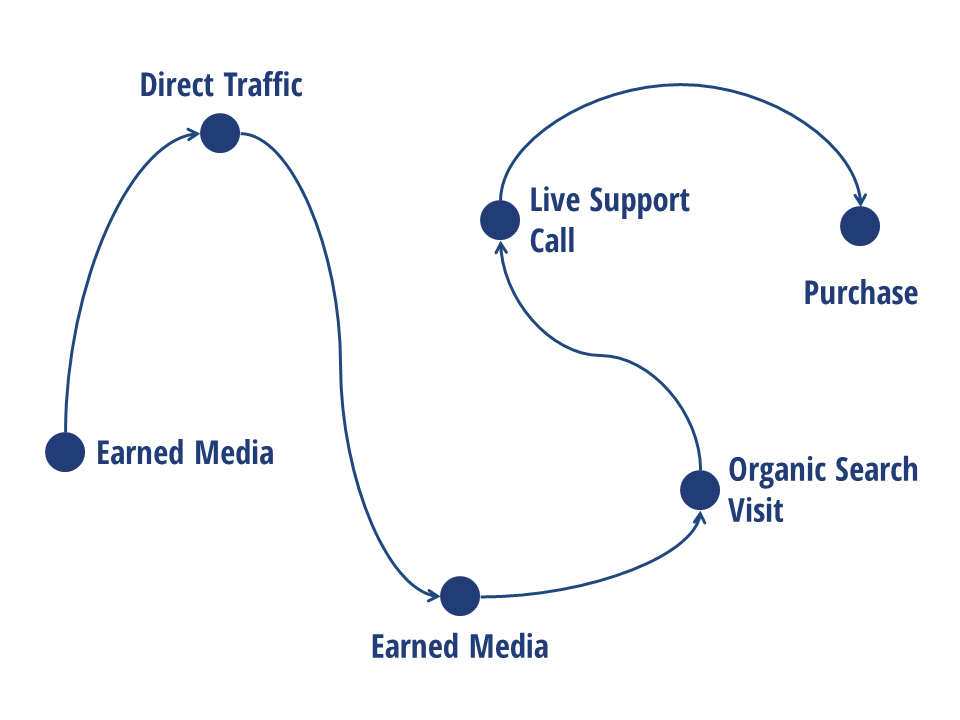 In the marketing world, we talk about the customer journey — the steps that your prospects go through in their decision-making process for whether to purchase from you or not — quite a bit. After all, you can’t find your prospects, connect with them, and establish trust with them without knowing what their decision-making process is actually like. With that in mind, I decided to eat our own dog food and recount a recent customer journey of my own — the journey of how I became a Zappos customer. Here’s how it happened:
In the marketing world, we talk about the customer journey — the steps that your prospects go through in their decision-making process for whether to purchase from you or not — quite a bit. After all, you can’t find your prospects, connect with them, and establish trust with them without knowing what their decision-making process is actually like. With that in mind, I decided to eat our own dog food and recount a recent customer journey of my own — the journey of how I became a Zappos customer. Here’s how it happened:
1. Awareness
Like many people, I’ve heard of Zappos on and off for several years, primarily through news, magazines and other journalistic publications. A lot of ink has been spilled describing Zappos’ customer service, their renovation of old town Las Vegas where they’re headquartered, and on founder Tony Hsieh himself. Every now and then, after hearing about them, I would manually visit their website (“direct traffic” in web analytics) and browse around a bit, but never buy anything. This went on for quite some time.
2. Consideration
Things got a little more interesting when I purchased a pair of shoes from Amazon. The shoes were from a European company and used the European shoe size system. It was difficult to tell which European shoe size was right for me, and to my chagrin, I bought a pair that turned out to be too large. When I put them on and realized my mistake, I immediately went to my computer and Googled “EU to US shoe size.” The top search result was a page on Zappos.com showing a size comparison chart, so I clicked on it (“organic search” in web analytics). Once I was on the Zappos site, I figured I might as well see if they had the same pair of shoes in the correct size — and they did!
3. Decision
Having messed up on choosing the right shoe size before, though, I needed a little more help to make sure that I would order the right size this time. So I decided to give Zappos a call and put their so-called legendary customer service to the test. They didn’t disappoint — the lady who answered their support line was extremely friendly and answered all my questions about European shoe sizing and how it translated to American shoe sizes. I had a business trip that I needed the shoes for very soon, and so the lady went the extra step of giving me complimentary overnight shipping so that I could get the shoes in time. Perfect! I promptly ordered the shoes from Zappos, returned the wrong-sized pair to Amazon, and that was that.
What Can We Learn From This?
I realized afterwards that my own customer journey with Zappos is indicative of the winding path that many people take when deciding to purchase or not purchase from a particular company. Zappos had several touchpoints with me through PR and earned media, interspersed with direct traffic website visits from me. Then they connected with me through organic search, resolved my concerns through their phone center, and finally made me a customer through a phone order. My journey would look something like this:

What this shows us is that, far from the straightforward visitor -> lead -> customer path we typically expect our prospects to take, in actuality the decision-making process is usually much longer, more meandering, and more complex. And the path will be significantly different for different people. For some Zappos customers, their path might have gone something more like this: Paid search visit -> Direct traffic visit -> Organic search visit (branded keyword) -> Direct traffic visit -> Email campaign visit -> customer. Other peoples’ paths might be more like this: Earned media -> Organic search visit (branded keyword) -> Social media visit -> Earned media -> Paid search visit -> Customer. Given the realities of these long and winding customer journeys, here are 3 key takeaways for marketers:
1. Consider All Possible Interaction Points
It took a lot of interactions between Zappos and myself to get me to become a customer. If Zappos only focused on one particular channel such as paid search advertising for specific types of shoes, it’s unlikely I would have come to their site at the moment I was considering a purchase. Likewise, if they only focused on organic SEO and neglected PR and earned media, I might not have even heard of them before finding them online, and I would be much less inclined to trust them enough to buy from them. If a company focuses only on a few specific channels for their marketing, they might get solid results from those channels, but they might inadvertently be leaving a lot of money on the table by ignoring the other avenues available to them.
2. Consider Often-Overlooked Needs
Zappos smartly realized that there are many people browsing shoes online who would need assistance in converting EU shoe sizes to US shoe sizes. So they very smartly made a page on their site addressing that exact need. Whereas the obvious SEO target for a shoe company would be keywords such as “men’s leather shoes,” “women’s dress shoes,” and so on, Zappos took a step back to ask what other questions and considerations are in their prospects minds besides just the actual shoes themselves, and consequently are now gaining large numbers of new website visitors by producing content to address those ancillary questions. Other marketers would do well to heed their example and think through every aspect of their own prospects’ buyer journeys to identify every single area they can assist their prospects with the information they need.
3. Don’t Underestimate the Things You Can’t Track
Even as web analytics get better and better, there are still things that you just can’t track. Prior to seeking out help with European shoe sizes, all my interactions with Zappos consisted of reading about them in earned media like magazines and blogs, and visiting their site directly — oftentimes on a variety of different devices. This means that Zappos was completely unable to track these interactions and unable to prove that those interacted contributed to my purchase in any way. But if it wasn’t for the level of trust that Zappos had already built up with me through their press coverage and my direct visits, it’s very unlikely I would have trusted them with my credit card info enough to buy something from them. Thus these interactions, while frustratingly hard to tie to revenue, are nevertheless absolutely essential for a company’s long-term success with their prospects.
Empathy For the Customer
Examining my customer journey with Zappos has made me a better marketer. I spend most of my time thinking from the perspective of a marketer trying to reach our prospects and our clients’ prospects. But taking a breather from that, and looking at things through the opposite perspective as a buyer, showed me the types of steps I need to go through when evaluating products and services, not just as a seller. It has consequently given me a newfound empathy and sensitivity to the needs of prospects and buyers in making the right decision for themselves, not just the right decisions for us marketers to try to sell more. I challenge you to go through a similar exercise in your own personal life as a buyer of a particular product or service. Think through all the questions and needs in your own mind, think through every interaction you went through with a company before buying from them, and think about what helped you and didn’t help you in the process. Taking a break from being in the mindset of the seller and being in the mindset of the buyer will give you a newfound sensitivity and appreciate to your own prospects’ wants and feelings. It will make you a better marketer, it will make you more of a hero to your boss, and it will eventually amp up the performance of the entire company.
